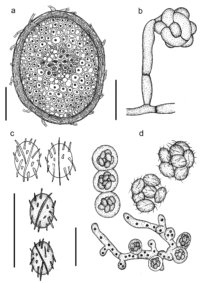Fungalpedia – Note 242, Aphanoascus
Aphanoascus Zukal, Ber. dt. bot. Ges.
Citation when using this entry: Thakshila et al. 2024 (in prep) – Fungalpedia, Onygenales, Eurotiales, and Verrucariales.
Index Fungorum, Facesoffungi, MycoBank, GenBank, Fig. 1
Classification: Onygenaceae, Onygenales, Eurotiomycetidae, Eurotiomycetes, Fungi
Zukal (1890) introduced Aphanoascus, which is characterized by Aphanoascus cinnabarinus as the type species. The strain was isolated from an alligator dung in Vienna, Austria. Based on morphological similarities, Apinis (1968) reported that Anixiopsis stercoraria and A. cinnabarinus were the same species. Udagawa & Takada (1973) isolated the neotype of A. cinnabarinus from the soil in Japan. Cano & Guarro (1990) reported that Anixiopsis cinnabarinus is distinct from A. stercoraria, by its reticulated and ridged ascospores. Anixiopsis cinnabarinus is characterized by superficial, subspherical to ovate cleistothecium ascomata, and the cleistothecium consists of pseudo-parenchymatous to scleroid membranous peridium. Asci are 8 spored, hyaline, and globose to subglobose. The ascospores are hyaline to pale yellow with an anastomosing ridge. Mycelia are branched, hyaline to pale yellowish orange, septate, and encrusted with pigmented granules (Udagawa & Takada 1973). Asci formation in Aphanoascus is similar to Eupenicillium and Hemicarpenteles (Udagawa & Takada 1973). However, the morphology of the ascomata and colony pigmentation of Aphanoascus differ from those of other genera. The ascomata of Thermoascus were similar to those of Aphanoascus. However, Aphanoascus has irregular ornamented ascospores, catenulate asci, and growth behavior at high temperatures, which distinguishes the genus from Thermoascus (Udagawa & Takada 1973).
Type species: Aphanoascus cinnabarinus Zukal, Ber. dt. bot. Ges.
Other accepted species: Species Fungorum – search (Aphanoascus)
Figure 1 – Aphanoascus cinnabarinus SEM. a Cleistothecium. b Initial of ascocarp. c Ascospores. d Various stages of asci. Scale bars: a = 50 μm, b-d = 10 μm. Redrawn from Udagawa & Takada (1973).
References
Jong SC. And Davis EE. 1975 – The imperfect state of Aphanoascus. Mycologia, 67(6), 1143–1147.
Entry by
Subasingha A. D. Thakshila, Center of Excellence in Fungal Research, School of Science, Mae Fah Luang University, Chiang Rai 57100, Thailand
(Edited by Chitrabhanu S. Bhunjun, Kevin D. Hyde, Samaneh Chaharmiri-Dokhaharani, & Achala R. Rathnayaka)
Published online 22 April 2024
